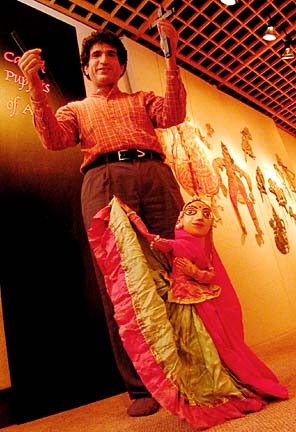Advertisement - Click to support our sponsors.


On his 21st birthday, Michael Schuster fell in love with a princess. He was in Burma, at a Buddhist temple in Rangoon, when he was smitten, "astounded by her beauty." Passion for puppets
By Cynthia Oi
Star-BulletinWanting her badly, he traded a travel alarm clock for her.
More than 20 years later, they are still together, but she isn't the only object of his affection.
Since that time, Schuster has acquired other loves in addition to the puppet princess who first enchanted him and he is showing off dozens of them as part of an exhibit, "Carved Puppets of Asia" at the East-West Center Gallery.
Schuster had been studying history in Israel and as he wandered home to the United States the long way through Asia, fate snared his heart for puppetry.
"In Burma, they would say it's a karmic response, like two dew drops that meet to make one, a moment of recognition."

From the recognition grew an intellectual passion. "I started to investigate a study in puppetry. There wasn't a lot, there was just a beginning interest in the whole performance of Asian puppetry at the time," he said.He returned to Southeast Asia and Indonesia, India and Europe, studying traditions of puppetry. Eventually, he came to the islands and earned a doctorate in Asian theater at the University of Hawaii at Manoa.
The East-West Center alumnus, who now works as folk arts coordinator for the State Foundation of Culture and the Arts, sees such traditional art forms as puppetry as endangered.
"It's all over the world -- the destruction of traditional arts," he said.
What may save puppetry is that it is deeply linked with the culture in many countries, he said. "In certain places, they are so deeply entrenched you'd see them performed regularly at weddings, major life events."
In Indonesia, for example, people treat performances, not just as entertainment, but as community events. "A lot of these are done with the patronage of, say, a temple. So if there's a festival, or a housewarming, everyone would be invited to come, everyone in the community."
It's an occasion for the whole family.
"These kinds of works never separate children and adults. That's a Western concept. This is a total art that's for everyone," he said.
Clown puppets entertain youngsters and those who want comedy, romantic stories and figures lure teens and adults, philosophy and social commentary attract the more serious, he said.
"Most would go on for several hours, sometimes all night long. The children would sleep until there was something exciting for them. People would leave for awhile and come back later. It is a different concept of entertainment."
Where puppetry in Asian cultures unites families and communities, American entertainment divides. Movies and television programs target audiences by age and other demographics, fragmenting what could be shared experiences.
"That kind of marketing mentality, where we separate children from adults in audiences, forms the sense of alienation," he said.
Puppetry in the United States differs by the medium in which it is transmitted. "We have puppet traditions like (Jim) Henson, the Muppets, Howdy Doody, Shari Lewis. Kukla, Fran and Ollie, but those are mass marketed, not from the individual performance art tradition."
Schuster laments the lack of attention folk art gets in America. "It's hard to support yourself as an artist in our society ... given the nature of our culture with its emphasis on mass media, mass advertising, mass consumerism."
"It's not part of our ideology or consciousness. We're involved with making money, buying things, selling things, making more money. We have a more traditional base in Hawaii, but even that's being eroded all the time."
The traditional performances of puppetry offers "a kind of glory of all this rich culture," he said.
"It's an intentional idea to create beauty from the ugliness, the bizarre, the strange, the poetic, the refined and the coarse. It is intended to pull beauty and wonder. We need to look at life like that, to take us out of the mundane, everyday moment to look around and reconnect.
"That's the valuable thing about being human, that we have this kind of collectiveness, we can share our expressions."
His thoughts return to the day he first saw his princess. "I don't exactly know what makes someone come alive to the things they love. I think I was really aware of the kind of alienated society that I lived in, that was so bent on destroying its links to its own roots."
But in puppetry, Schuster sees the unveiling of "this kind of magic, this spirituality, this fantasy, this miniature world that can come alive. That's just glorious."
'Carved Puppets of Asia'
On display: Wooden puppets from Vietnam, Thailand, India, Indonesia, Myanmar and India.
Place: East-West Center Gallery, John A. Burns Hall
Dates: 8 a.m. to 5 p.m. weekdays and noon to 5 p.m. Sundays through March 23
Demonstrations: Indian puppets, 10 a.m. Monday and Feb. 15; Indonesian puppets, 10 a.m. March 16 and 19.
Call: 944-7198
Click for online
calendars and events.